Eastern Tent Caterpillars Cause Early Fetal Loss
A recent study funded by Grayson-Jockey Club Research Foundation, Rood and Riddle Equine Hospital, and several other entities, identified an association between the administration of starved Eastern Tent Caterpillars (ETC) and early pregnancy
A recent study funded by Grayson-Jockey Club Research Foundation, Rood and Riddle Equine Hospital, and several other entities, identified an association between the administration of starved Eastern Tent Caterpillars (ETC) and early pregnancy loss in the mare. The study had support from Taylor Made Farm, Ernie Paragallo, Fasig-Tipton Co. and the Kentucky Thoroughbred Farm Managers Club, and was conducted by Bill Bernard, DVM, Dipl. ACVIM, and Michelle LeBlanc, DVM, Dipl. ACT, and Bruce Webb, PhD.
The study involved three groups of mares. One group received starved caterpillars, one group received caterpillar frass (waste), and one group served as control. Four of five mares administered caterpillars lost pregnancies within eight to 13 days subsequent to the first dose of ETC. No control mares or mares that received frass aborted.
The project design consisted of three groups of five mares each. Mares were administered their respective treatment by nasogastric tube for 10 days. Group one mares served as controls and received 50 ml of water, group 2 mares received 2.5 grams of stored frass diluted in 50 ml of water, and group 3 mares received 50 grams of crushed fresh ETC mixed in 50 ml of water.
Mares were housed in stalls with no exposure to grass beginning 12 days before they were given any treatment and remained in stalls for the entire experimental period. Mares were walked twice daily to provide exercise. Mares were between 38 and 88 days of gestation on day one of treatment. The mares that aborted were 49, 64, 70, and 96 days of gestation. Alpha streptococcus was cultured from one aborted fetus while Serratia was cultured from the remaining three fetuses. Neither pericarditis nor ophthalmologic disease was observed
Create a free account with TheHorse.com to view this content.
TheHorse.com is home to thousands of free articles about horse health care. In order to access some of our exclusive free content, you must be signed into TheHorse.com.
Start your free account today!
Already have an account?
and continue reading.

Written by:
The Horse Staff
Related Articles
Stay on top of the most recent Horse Health news with












